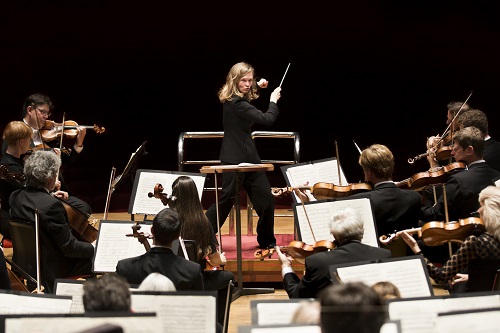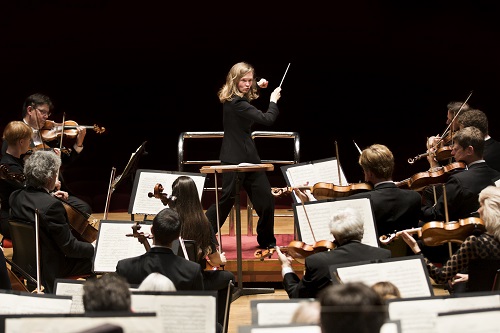 United Kingdom Mahler: Lucy Crowe (soprano), Karen Cargill (mezzo Soprano), CBSO Chorus, City of Birmingham Symphony Orchestra / Mirga Gražinytė-Tyla (conductor), Symphony Hall, Birmingham, 13.6.2019. (JQ)
United Kingdom Mahler: Lucy Crowe (soprano), Karen Cargill (mezzo Soprano), CBSO Chorus, City of Birmingham Symphony Orchestra / Mirga Gražinytė-Tyla (conductor), Symphony Hall, Birmingham, 13.6.2019. (JQ)

Mahler – Symphony No.2 in C minor, ‘Resurrection’
‘Aufersteh’n, ja aufersteh’n / Wirst du, mein Herz, in einem Nu!’ (Rise again, yes, you will rise again, / My heart, in an instant) is the ecstatic proclamation of the chorus in the closing moments of Mahler’s ‘Resurrection’ Symphony. But, my goodness, Mahler takes his listener on a colossal and eventful journey before arriving at that point. The symphony takes us from a darkly dramatic funeral rite, through a series of intermezzo-like movements and a depiction of Judgement Day, to the soul’s liberation through Resurrection. Vast choral and orchestral forces are required and the highly-charged nature of the work makes it a compelling proposition. Small wonder, then, that there was scarcely a spare seat in Symphony Hall for tonight’s performance.
During her time as Osborn Music Director of the CBSO I think I am right in saying that Mirga Gražinytė-Tyla has so far conducted two Mahler symphonies: The First and the Fourth. I have missed those performances so I was keen to hear what she’d make of the altogether bigger canvass that is the ‘Resurrection’ Symphony.
Of course, the CBSO and its Chorus are no strangers to this work. It was a favourite ‘big occasion’ piece for Sir Simon Rattle; various guest conductors have led performances too; and I vividly recall an electrifying account of the work by Ms Gražinytė-Tyla’s predecessor, Andris Nelsons in 2012. By sheer coincidence, in the days leading up to tonight’s performance I’d been watching a recently-released Blu-ray video of Nelsons conducting the Vienna Philharmonic in this work at the 2018 Salzburg Festival. This was in connection with a forthcoming review for MusicWeb International. That Nelsons performance is very fine but the medium of video seems to me to limit the work; it becomes too contained by the confines of a TV screen and, as tonight proved in spades, there is nothing like experiencing this great work live.
Ms. Gražinytė-Tyla began the huge first movement purposefully, the interpretation – and the playing – full of energy. Within a few minutes it was clear that we were to experience a reading of the movement that was full of drama and punch. The sheer conviction of the performance largely swept all before it, even if there were one or two occasions when I felt that a transition between episodes could have been handled just a little more easefully. The nostalgic passages, which are marked zurückhaltend (holding back), were beautifully delivered, the playing bringing out the nostalgic warmth of the recollective music. In these sections Gražinytė-Tyla’s pacing was properly expansive but I was glad to see that she didn’t draw the music out so much as to sacrifice momentum – a trap into which I’ve heard more than one conductor fall in the past. Elsewhere, the performance was vivid and characterised by great urgency. Once or twice I thought the music was pressed forward just a bit too swiftly – at one point I scribbled in my notes “school of Solti” – but overall the results were very exciting. The CBSO played with burning commitment and the brass and percussion sections made especially telling contributions, though I couldn’t help feeling that the second timpanist was a little over-zealous at times. The urgency of the performance was reflected in the overall timing: by my watch the movement played for approximately 22 minutes, which is on the fast side. Sure enough, when I got home and checked the timings of several recordings, randomly selected from my collection, there appeared to be what I might call a consensus timing of between 23 and 24 minutes. However, I made a particular point of looking up two recordings. My “school of Solti” impression was vindicated when I saw that in his 1966 LSO recording, the first I ever owned, the first movement runs for 21:15. Perhaps more surprisingly, in Otto Klemperer’s great 1962 recording – still a benchmark – I was reminded that the first movement “flashes by” in 19:02. So, if Ms. Gražinytė-Tyla’s overall traversal was fleet, she was in good company.
Mahler specified a pause of five minutes after the first movement. No doubt this was to allow audiences – and musicians – to reflect and get back their collective breath. Nowadays, that injunction is more honoured in the breach, and rightly so. Such a lengthy pause dissipates the tension and, inevitably, the audience will start to fidget. Wisely, Mirga Gražinytė-Tyla left a gap of about a minute, which was just right.
Much of the Andante moderato second movement was relaxed and easy in its demeanour. I admired the graceful playing of the CBSO strings and, in particular, the tonal warmth of the cello section at various points. One episode, which is mainly for harps and pizzicato strings, was pointed delectably. The faster section in the middle of the movement was nimbly played. Overall, the music of this movement flowed in an ideal fashion. There follows a Scherzo based on Mahler’s song from Des Knaben Wunderhorn, ‘Des Antonius von Padua Fischpredigt’ about St Anthony preaching to the fishes. Before it began the two soloists took their places on the platform. The Scherzo was nicely articulated and shaded. I thought the tempo selection was excellent and lots of the sharply edged detail in Mahler’s mordantly witty scoring came out. The nostalgic passage midway through, in which a solo trumpet is prominent, was savoured to the full – but not overdone. Shortly before the movement’s end the premonition of the finale shattered the folksy Wunderhorn ambience, giving us a foretaste of what lies in store.
Karen Cargill was an ideal soloist in ‘Urlicht’, another Wunderhorn song. She and Lucy Crowe were seated in a rather unusual place, on the conductor’s left, behind the violins and next to the harps. However, so perfect are the acoustics of Symphony Hall that the solo voices could clearly be heard. Miss Cargill sang with great expression and lovely, full tone and her diction was excellent. I had scarcely scribbled down that her delivery of the first half of the song was especially lovely than she treated us to a rapt delivery of the closing bars.
Mahler shatters the Wunderhorn innocence of the middle three movements at a stroke with the apocalyptic eruption with which the finale begins. What follows is a vast and incident-packed musical fresco in which Mahler depicts nothing less than the Last Judgement. I can think of few venues better suited than Symphony Hall to this 33-minute-long (in this performance) piece of symphonic music-drama. In particular, the layout allows the offstage horns and, later, the trumpets, to make a stunning effect, as was the case tonight. The performance was gripping and totally assured: my one disappointment was that when the ‘Resurrection’ chorale was softly and solemnly intoned by low brass and contrabassoon, the ensemble was less than ideally balanced: the tuba was too prominent. But this was an isolated blemish. Mirga Gražinytė-Tyla grabbed the music by the scruff oi its neck and visibly urged her orchestra on – urging to which they responded superbly. After the two huge percussion crescendi, the quick march episode that follows was brisk and very exciting; this was edge-of-the-seat stuff. The march led, with great urgency, to the moment where the musical cataclysm heard near the end of the third movement is reprised, but to even more terrifying effect, as the music plunges over the abyss; in this performance it was a truly apocalyptic moment.
The grosse Appell was marvellously depicted, the atmosphere electric. Here, the offstage brass – horns to the conductor’s left, trumpets to her right – made a telling impact and the last fragile vestiges of human life were depicted by Sarah Newbold (flute) and Nei Asakawa (piccolo). The CBSO Chorus, singing from memory and, initially, seated so as not to break the spell by standing up, were ideal at their initial entry, the singing hushed yet clear. Lucy Crowe was the soloist on the Andris Nelsons video performance that I mentioned earlier. She impressed me then and now, heard live, she made, if anything, a stronger impression, her initial phrases rising sweetly as the voice of redemptive reassurance. The ‘O Glaube’ passage showed that the two soloists were perfect foils for each other, singing with fine expression. The choral singing, too, was of a very high order; one would expect nothing less of this choir, especially in this work which must, by now, be woven into their musical DNA. Ms. Gražinytė-Tyla spurred her forces ever onwards to the moment of blazing affirmation of the choir’s fff proclamation: ‘Aufersteh’n, ja aufersteh’n’. Here, choir and orchestra were fervent in their delivery of Mahler’s music, the ensemble enriched by the majestic sound of Symphony Hall’s organ and with the four horns and four trumpeters brought from their offstage stations to reinforce the brass from a high vantage point by the organ console. The closing pages were as thrilling as they should be; no wonder the audience greeted the performance rapturously when it was all over.
This blazing performance was one of the best things – perhaps the best thing – that I have heard Mirga Gražinytė-Tyla do during her time in Birmingham. It was a reading of drama and conviction and she inspired her players and singers to give of their very best in the cause of this great symphony.
John Quinn

So pleased to see you giving this such a glowing report John. It was indeed a most memorable concert. {Edited comment]
Great review of an excellent performance.
The only quibble I have is that the violins should have been split left and right, as Mahler intended.
ALL music prior to Mahler was written for spilt strings. It is not an excuse to say that violins don’t like it. That’s just because they are not used to it – well they jolly well should get used to it.
Though I didn’t comment on the issue in my review, I agree strongly with Tim Walton’s point about divided violins. If you listen to the classic Klemperer recording, where the violins are splits left and right, the benefits are obvious right from the start. At the beginning of the symphony those violin tremolandi are heard right across the breadth of the orchestra and the cello/bass eruptions come from the left-hand centre of the aural picture. It’s gripping. Of course, the same happens every time Mahler repeats that material. The great benefits of divided violins can be heard elsewhere, not least in the second movement where the listener can really appreciate the difference and interplay between the two violin parts.
Sir Simon Rattle’s superb Symphony Hall performance of the Ninth symphony in May 2018 showed the enormous gains that come from dividing the violins. If Mirga Gražinytė-Tyla conducts the Second symphony again – and I hope very much that she will – then it would be great if she divided the CBSO’s violins left and right.
My wife and I were at the Sunday afternoon performance. It was a stunning and spiritually uplifting experience. It compared very favourably to a performance with Rattle and the Berlin Philharmonic which we heard at the Royal Festival Hall a few years ago.